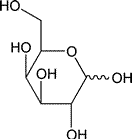Add the following:
»Galactose is one of the products of the metabolism of lactose,a naturally occurring sugar in dairy products,by the digestive enzyme lactase.
Appearance of solution—
Dissolve,with heating at 50 ,10.0g of galactose in 50mLof carbon dioxide-free water.The solution is not more intensely colored than a solution prepared immediately before use by mixing 3.0mLof ferric chloride CS,3.0mLof cobaltous chloride CS,and 2.4mLof cupric sulfate CSwith dilute hydrochloric acid (10g per L)to make 10mL,and diluting 1.5mLof this solution with the dilute hydrochloric acid to 100mL.Make the comparison by viewing the substance and the solution downward in matched color-comparison tubes against a white surface (see Color and Achromicity á631ñ).
,10.0g of galactose in 50mLof carbon dioxide-free water.The solution is not more intensely colored than a solution prepared immediately before use by mixing 3.0mLof ferric chloride CS,3.0mLof cobaltous chloride CS,and 2.4mLof cupric sulfate CSwith dilute hydrochloric acid (10g per L)to make 10mL,and diluting 1.5mLof this solution with the dilute hydrochloric acid to 100mL.Make the comparison by viewing the substance and the solution downward in matched color-comparison tubes against a white surface (see Color and Achromicity á631ñ).
Identification—
A:Infrared Absorption á197Kñ.
B:Thin-Layer Chromatographic Identification Test á201ñ—
Test solution—
Dissolve 10mg in 20mLof a mixture of methanol and water (3:2).
Standard solution 1:
500µg per mLin a mixture of methanol and water (3:2).
Standard solution 2—
Prepare a solution using USP Galactose RS,USP Dextrose RS,and USP Lactose Monohydrate RS,each at a concentration of 500µg per mLin a mixture of methanol and water (3:2).
Application volume:
2µL.
Developing solvent system:
propanol and water (85:15).
Procedure—
Develop the plate in an unsaturated tank.After the solvent front has moved over 15cm,remove the plate from the tank.Dry the plate with warm air,then spray the plate with a thymol solution (0.5g in a mixture of alcohol and sulfuric acid [95:5]).Heat for 10minutes in an oven at 130 .The RFof the principal spot obtained from the Test solutioncorresponds to that obtained from the Standard solution.[NOTE—There must be three clearly resolved spots in the chromatogram for Standard solution 2in order for the results to be valid.]
.The RFof the principal spot obtained from the Test solutioncorresponds to that obtained from the Standard solution.[NOTE—There must be three clearly resolved spots in the chromatogram for Standard solution 2in order for the results to be valid.]
Specific rotation á781Sñ:
between +78.0 and +81.5
and +81.5 at 20
at 20 .
.
Test solution:
Transfer 10.0g to a 100-mLvolumetric flask,and dissolve in 80mLof water.Add 0.2mLof ammonia TS,allow to stand for 30minutes,then dilute with water to volume.
Microbial limits á61ñ:
It meets the requirements of the test for absence of Salmonella species,Escherichia coli,Staphylcoccus aureus,and Pseudomonas auruginosa.The total aerobic microbial count does not exceed 1000cfu per g,and the total combined molds and yeasts count does not exceed 100cfu per g.
Acidity—
Dissolve 10.0g,with heating at 50 ,in 40mLof carbon dioxide-free water.Dilute with carbon dioxide-free water to 50mL[NOTE—Use this solution for the Bariumtest].To 30mLof this solution,add 0.3mLof phenolphthalein TS,and titrate with 0.01Nsodium hydroxide to a pink color:not more than 1.5mLof 0.01Nsodium hydroxide is required to produce a pink color.
,in 40mLof carbon dioxide-free water.Dilute with carbon dioxide-free water to 50mL[NOTE—Use this solution for the Bariumtest].To 30mLof this solution,add 0.3mLof phenolphthalein TS,and titrate with 0.01Nsodium hydroxide to a pink color:not more than 1.5mLof 0.01Nsodium hydroxide is required to produce a pink color.
Water,Method Iá921ñ:
not more than 1.0%.
Residue on ignition á281ñ:
not more than 0.1%.
Barium—
Standard solution—
Add 6mLof water to 5mLof the solution prepared for the Aciditytest.
Test solution—
Add 5mLof water and 1mLof dilute sulfuric acid to 5mLof the solution prepared for the Acidity test.Allow to stand for 1hour:any opalescence in the Test solutionis not more intense than that of the Standard solution.
Limit of lead—
Diluent—
Dilute 12mLof acetic acid with water to 100mL.Mix equal parts of this solution and water to prepare the Diluent.
Lead standard stock solution—
Transfer an accurately weighed quantity of lead nitrate,about 400mg,to a 250-mLvolumetric flask,dilute with water to volume,and mix.
Lead standard solution—
Dilute 1.0mLof Lead standard stock solutionwith water to 10mL.Dilute 1.0mLof this solution with water to 10mL.
Standard solutions—
To three identical flasks,add 0.5mL,1.0mL,and 1.5mLof Lead standard solution,respectively,and then add to each flask 20.0g of galactose.Dilute with Diluentto 100mL.To each flask add 2.0mLof ammonium pyrrolidinedithiocarbamate solution (10g per L)and 10.0mLof methyl isobutyl ketone,then shake for 30seconds.[NOTE—Protect from light.]Allow the layers to separate,and use the methyl isobutyl ketone (upper)layer for analysis.
Test solution—
Dissolve 20.0g of Galactose in Diluent,and dilute with Diluentto 100mL.Add 2.0mLof ammonium pyrrolidinedithiocarbamate solution (10g per L)and 10.0mLof methyl isobutyl ketone,and shake for 30seconds.[NOTE—Protect from light.]Allow the layers to separate,and use the methyl isobutyl ketone (upper)layer for analysis.
Procedure—
Concomitantly determine,at least in triplicate,the absorbances of the Standard solutionsand the Test solutionat 283.3nm with a suitable atomic absorption spectrophotometer (see Spectrophotometry and Light-Scattering á851ñ)equipped with a lead hollow-cathode lamp as the radiation source and an air–acetylene flame.Record the average steady readings for each of the Standard solutionsand the Test solution.Plot the absorbances of the Standard solutionsand the Test solution versus the amount of lead added.Extrapolate the line joining the points on the graph until it meets the concentration axis.The distance between this point and the intersection of the axes represents the concentration of lead in the Test solution:not more than 0.5µg per g is found. NF23
NF23
Auxiliary Information—
Staff Liaison:Karen A Russo,Ph.D.,Scientist
Expert Committee:(EMC)Excipients:Monograph Content
USP28–NF23Page 3008
Pharmacopeial Forum:Volume No.30(2)Page 600
Phone Number:1-301-816-8379
